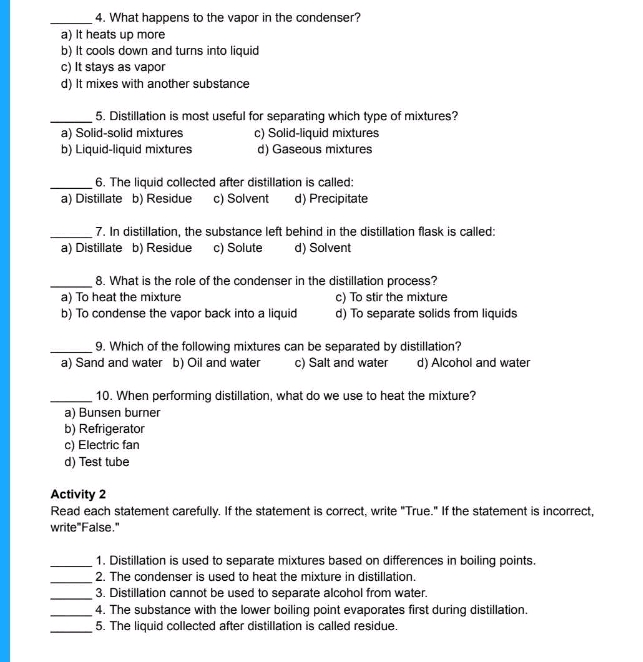4 What happens to the vapor in the condenser a It heats up more b It cools down and turns into liquid c It stays as vapor d It mixes with another substance 5 Distillation is most useful for separating...
Question

🤔 Not the exact question you're looking for?
Key Concept
Distillation Process and Components
Basic Answer
Solution By Steps
Step 1: Understanding the Process in a Condenser The vapor in the condenser cools down and turns into liquid.
Step 2: Identifying the Most Useful Application of Distillation Distillation is most useful for separating liquid-liquid mixtures.
Step 3: Naming the Collected Liquid After Distillation The liquid collected after distillation is called distillate.
Step 4: Identifying the Substance Left Behind in the Distillation Flask The substance left behind in the distillation flask is called residue.
Step 5: Understanding the Role of the Condenser in Distillation The condenser in the distillation process is used to condense the vapor back into a liquid.
Step 6: Determining Which Mixtures Can Be Separated by Distillation Mixtures that can be separated by distillation include alcohol and water.
Step 7: Identifying the Heating Source in Distillation In distillation, a Bunsen burner is used to heat the mixture.
Step 8: Evaluating Statements About Distillation
- True - Distillation separates mixtures based on differences in boiling points.
- False - The condenser cools the vapor, not heats the mixture.
- False - Distillation can separate alcohol from water.
- True - The substance with the lower boiling point evaporates first.
- False - The liquid collected after distillation is called distillate, not residue.
Final Answer
- b) It cools down and turns into liquid
- b) Liquid-liquid mixtures
- a) Distillate
- b) Residue
- b) To condense the vapor back into a liquid
- d) Alcohol and water
- a) Bunsen burner
Activity 2:
- True
- False
- False
- True
- False
Answered Sep 3 at 02:27 by StudyX AI with Basic Model
Super AI
😉 Want a more accurate answer?
Use Super AI for a more accurate answer or choose from latest top models like o1 mini, GPT-4o, or Claude 3.5 Sonnet for a tailored solution.
New questions in Calculus
write down the structure of alternating and block copolymer obtained from the monomer acryamide and acrylonitrile
Write the name of hydrocarbons formed when methyl magnesium iodide is treated with ammonia
Difference between aliphatic and cyclic hydrocarbons class 11
In one a application a 0.01 mm layer of chromium must be deposited on a part with a total surface area of 3.3 m² from a solution containing chromium (3) ion's. How long would it take to deposit the layer of chromium? If your turn was 3.46A. The density of chromium metal is 7.19g/cm^3 Givr the best solution
green chemistry principles involved in green synthesis of adipic acid
Join StudyX for more
See more homework solutions
Get answers with top AI models
Collaborate with millions of learners
🤔 Not the question you're looking for?
Join StudyX for more
See more homework solutions
Get answers with top AI models
Collaborate with millions of learners
